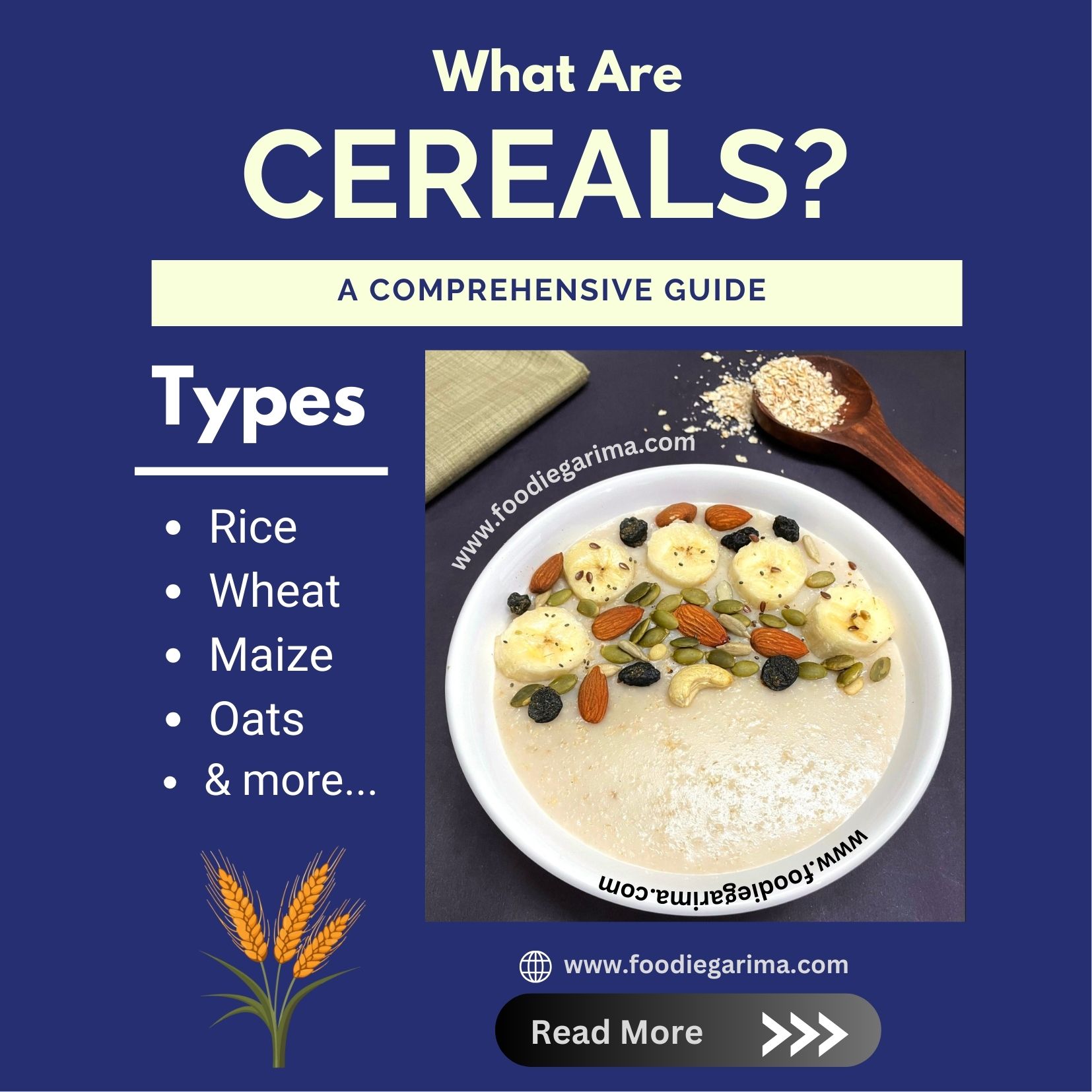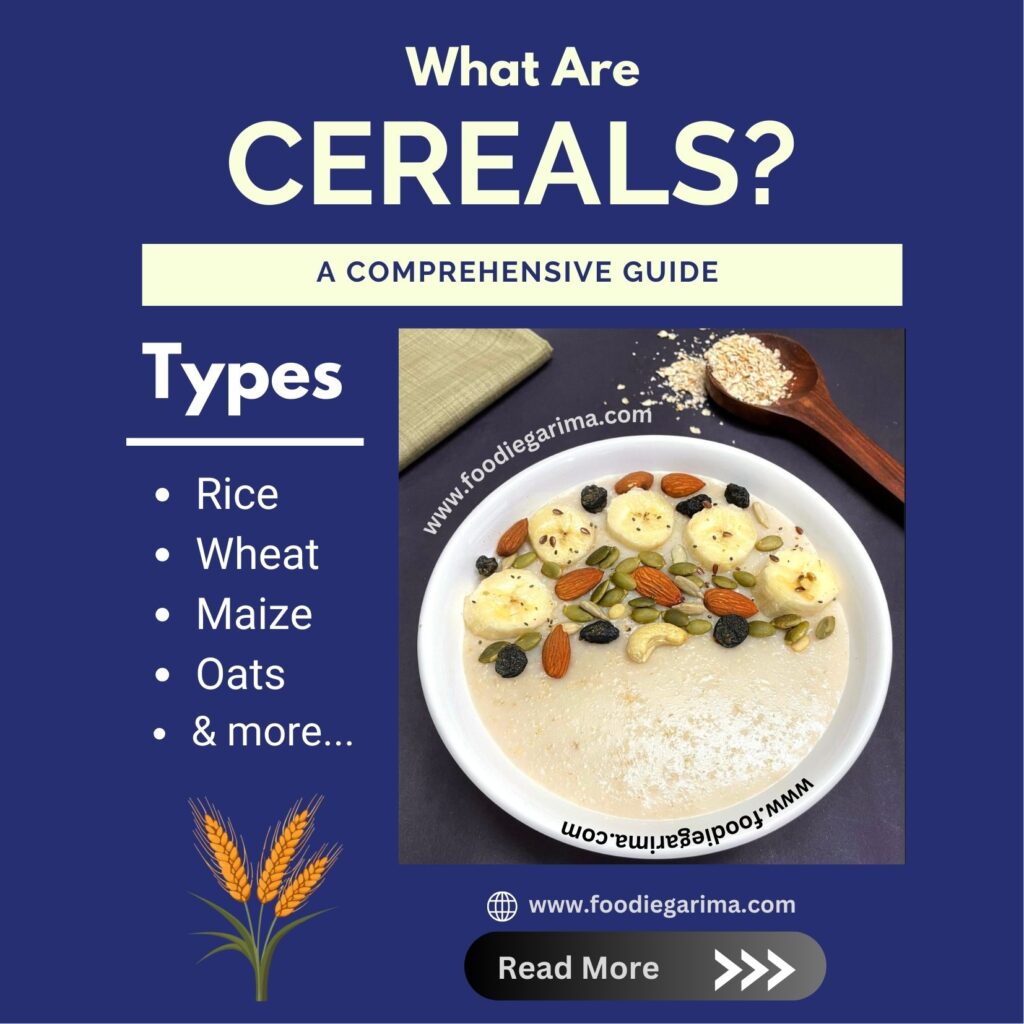7 January, 2025
What Are Cereals: A Comprehensive Guide to the Staple of Global Diets

What Are Cereals: A Comprehensive Guide to the Staple of Global Diets
Cereals have been a cornerstone of human nutrition for thousands of years. These humble grains are not only vital to feeding the world but also form the base for countless culinary creations. But what exactly are Cereals, and why are they so important? Let’s dive into the fascinating world of cereals and uncover their significance, varieties, and uses.
What Are Cereals?
Cereals are edible seeds or grains from grasses belonging to the Poaceae family. They are cultivated worldwide for their high carbohydrate content and serve as a staple food source for much of the global population. Common Cereals include Rice, Wheat, Maize, Barley, Oats, Rye, Sorghum, and Millet.
Characteristics of Cereals
- High Carbohydrate Content: Cereals are rich in complex carbohydrates, providing energy for daily activities.
- Source of Nutrients: They contain varying levels of proteins, vitamins (especially B-complex), and minerals like iron, magnesium, and zinc.
- Versatile and Adaptable: Cereals can be processed into flour, flakes, or other forms, making them suitable for diverse dishes.
- Long Shelf Life: When stored properly, cereals can last for extended periods, making them an essential part of food security.
Popular Types of Cereals
1. Rice
- Origin: Predominantly grown in Asia.
- Varieties: Basmati, jasmine, arborio, and sticky rice.
- Uses: A staple in dishes like risotto, sushi, and pilaf.
2. Wheat
- Origin: Native to the Fertile Crescent.
- Forms: Whole wheat, refined wheat flour, bulgur, and semolina.
- Uses: Bread, pasta, pastries, and couscous.
3. Maize (Corn)
- Origin: Central America.
- Forms: Cornmeal, polenta, popcorn, and sweetcorn.
- Uses: Tortillas, cornbread, and breakfast cereals.
4. Barley
- Origin: One of the oldest cultivated grains.
- Forms: Hulled, pearled, and malted barley.
- Uses: Soups, stews, and beer production.
5. Oats
- Origin: Temperate regions.
- Forms: Rolled oats, steel-cut oats, and oat flour.
- Uses: Porridge, granola, and oat milk.
6. Millet
- Origin: Grown in arid regions.
- Varieties: Pearl millet, finger millet, and foxtail millet.
- Uses: Flatbreads, porridge, and fermented beverages.
7. Rye
- Origin: Eastern Europe.
- Uses: Rye bread, crackers, and whiskey production.
8. Sorghum
- Origin: Africa.
- Uses: Gluten-free flour, porridges, and syrups.
Processing of Cereals
Cereals undergo various levels of processing to enhance their usability:
- Milling: Removing the outer husk to produce refined grains like white rice or flour.
- Polishing: Enhancing the appearance and texture of grains like rice.
- Rolling: Flattening grains like oats for quicker cooking.
- Fermentation: Used in products like sourdough bread and beer.
Cereals in Modern Diets
In contemporary diets, cereals are consumed in various forms:
- Whole Grains: Retain their bran and germ, offering maximum nutrients.
- Refined Grains: Processed to remove the bran and germ, resulting in a smoother texture but fewer nutrients.
- Fortified Grains: Enriched with added vitamins and minerals to compensate for nutrient loss during processing.
Cereals in Global Cuisine
Cereals have been the foundation of countless traditional dishes:
- Asia: Sushi (rice), noodles (wheat), and congee (rice).
- Europe: Pasta (wheat), porridge (oats), and polenta (corn).
- Africa: Injera (teff), couscous (wheat), and ugali (maize).
- Americas: Cornbread, tortillas (corn), and oatmeal.
Tips for Choosing and Storing Cereals
- Choose Whole Grains: Opt for whole-grain varieties for maximum nutritional benefits.
- Check Labels: Look for minimal additives and higher fiber content.
- Proper Storage: Store cereals in a cool, dry place in airtight containers to prevent spoilage and pest infestation.
Nutritional Value of Cereals
Cereals are a powerhouse of nutrients:
- Carbohydrates: Provide energy.
- Protein: Essential for growth and repair.
- Fiber: Aids in digestion and promotes gut health.
- Vitamins: Especially B-complex vitamins like thiamine, niacin, and riboflavin.
- Minerals: Iron, magnesium, zinc, and selenium.
Health Benefits of Cereals
- Energy Booster: High carbohydrate content fuels the body and brain.
- Heart Health: Whole grains help reduce cholesterol and support cardiovascular health.
- Weight Management: High fiber content promotes satiety.
- Disease Prevention: Regular consumption of whole grains is linked to lower risks of diabetes and certain cancers.
- Digestive Health: Fiber aids in maintaining regular bowel movements.
Cereals are the backbone of human diets, providing essential nutrients and energy. Their versatility in cooking and adaptability to various climates make them indispensable in global food systems. By incorporating a variety of whole grains into your meals, you can enjoy their full nutritional benefits while exploring diverse culinary traditions.
FAQs
1. What is the difference between Cereals and Grains?
Cereals are a type of Grain specifically from the Poaceae family, while Grains also include Seeds from other plants like Quinoa and Amaranth.
2. Are Cereals gluten-free?
Some Cereals like Rice, Maize, and Millet are naturally gluten-free, while others like Wheat and Barley contain gluten.
3. Can Cereals help with weight loss?
Yes, whole Cereals are high in fiber and can promote satiety, aiding in weight management.
4. Are refined Cereals unhealthy?
Refined Cereals lose some nutrients during processing but can still be part of a balanced diet when fortified.
5. How can I incorporate more whole Cereals into my diet?
Swap refined Grains with whole Grains like brown Rice, whole Wheat bread, and Oatmeal for added fiber and nutrients.
